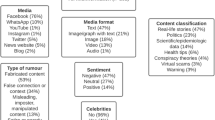Abstract
On 12 January 2020, the World Health Organization (WHO) confirmed that a novel coronavirus was the cause of a respiratory illness in a cluster of people in Wuhan City, Hubei Province, China, which was reported to the WHO on 31 December 2019. The case fatality ratio for coronavirus disease 2019 (Covid-19) has been much lower than SARS of 2003, but the transmission has been significantly greater, with a significant total death toll. As of 20 May 2020, there are a total of 5,085,449 confirmed cases and 329,239 death cases in the world with more than 200 countries affected. Malaysia reported a total of 7,009 confirmed cases, 5,706 recoveries and 114 deaths. According to the Global Web Index (GWI), it can be seen that there is a significant increase in the usage of social media among global users for the past month, including Facebook, Instagram and WhatsApp. By going online, people can stay updated to the news more easily and information can be spread at a higher speed. However, it can also bring negative impact among the users when people misuse this platform to spread fake news, causing misconception, anxiety and fear as they become “viral”. The spread of fake news can lead to several misconceptions among social media users, which can cause unnecessary fear and anxiety. For example, when Movement Control Order (MCO) was first announced in Malaysia on 16 March 2020, fake news about the shortage of food supply spread through the social media within hours, and this had led to more people rushing to the supermarkets to stock up their groceries. This paper discussed the transmission of fake news to understand the rate of spreading. Therefore, the objectives of this paper are to propose a mathematical model that can describe the dynamics of the spread of fake news through social media along the period of MCO through different social media platforms. This study also suggests some measures that can be taken by different parties, such as individuals, society and government to solve the issue of fake news transmission.
Access this chapter
Tax calculation will be finalised at checkout
Purchases are for personal use only
Similar content being viewed by others
References
Worldometers.: Coronavirus worldwide graphs. Retrieved from https://www.worldometers.info/coronavirus/worldwide-graphs/#total-cases (2020). Accessed 15 April 2020
Frenkel, S., Alba, D., Zhong, R.: Surge of Virus Misinformation Stumps Facebook and Twitter. New York Times. Retrieved from https://www.nytimes.com/2020/03/08/technology/coronavirus.misinformation-socialmedia.html (2020). Accessed on 2 April 2020
Pradhan, D., Biswasroy, P., Ghosh, G., Rath, G.: A review of current interventions for COVID-19 prevention. Archives Med. Res. (2020). Accessed 28 April 2020
Russonello, G.: Afraid of coronavirus? That might say something about your politics. New York Times. Retrieved from https://www.nytimes.com/2020/03/13/us/politics/coronavirus.trump-polling.html (2013). Accessed 5 April 2020
Sharot, T., Sunstein, C.R.: How people decide what they want to know. Nature Human Behav 1–6 (2020). Accessed 25 April 2020
Bovet, A., Makse, H.A.: Influence of fake news in twitter during the 2016 us presidential election. Nature commun. 10(1), 1–14 (2019). Accessed on 25 March 2020
Smith., K : 60 Incredible and interesting twitter stats and statistics. Retrieved from https://www.brandwatch.com/blog/twitter-stats-and-statistics (2020). Accessed 10 April 2020
Vosoughi, S., Roy, D., Aral, S.: The spread of true and false news online. Science, 359(6380) 1146–1151 (2018). Accessed 29 March 2020
Zakary, O., Rachik, M., Elmouki, I.: On the analysis of a multi-regions discrete SIR epidemic model: an optimal control approach. Int. J. Dyn. Control 5(3), 917–930 (2017). Accessed 21 April 2020
Ledzewicz, U., Schättler, H.: On optimal singular controls for a general SIR-model with vaccination and treatment. In: Conference Publications, vol. 2011, No. Special, p. 981 (2011). Accessed 2 April 2020
Khurana, P., Kumar, D.: Sir model for fake news spreading through whatsapp. In Proceedings of 3rd International Conference on Internet of Things and Connected Technologies (ICIoTCT) pp. 26–27 (2018)
OmnicoreAgency.: Snapchat by the numbers: stats, demographics & fun facts. Retrieved from https://www.omnicoreagency.com/snapchat-statistics (2020). Accessed 25 April 2020
Hern, A. (2020). WhatsApp to impose new limit on forwarding to fight fake news. Retrieved from https://www.theguardian.com/technology/2020/apr/07/whatsapp-to-impose-new-limit-on-forwarding-to-fight-fake-news, 15 April 2020
Workmacro.: What your follower/ following ratio say about your instagram account. Retrieved from https://workmacro.com/instagram/follower-following-ratio-say-instagram-account/ (2018). Accessed 29 March 2020
Smith., K.: 60 Incredible and interesting twitter stats and statistics. Retrieved from https://www.brandwatch.com/blog/twitter-stats-and-statistics/ (2020). Accessed 10 April 2020
OmnicoreAgency.: Snapchat by the numbers: stats, demographics & fun facts. Retrieved from https://www.omnicoreagency.com/snapchat-statistics/ (2020). Accessed 10 April 2020
Ignatius, D.: Modeling the spread of information on twitter Doctoral dissertation, California State Polytechnic University, Pomona (2018). Accessed 2 April 2020
American Institute of Mathematical Sciences.: Data Policy. Instagram data policy. https://help.instagram.com/519522125107875 (2020). Accessed on 2, 5 April 2020
Statista.: Facebook users in the United Kingdom (UK) from september 2018 to March 2020. Retrieved from https://www.statista.com/statistics/1012080/uk-monthly-numbers-facebook-users/ (2020). Accessed 26 April 2020
Global Web Index.: Coronavirus Research: Media Consumption and Sport. Retrieved from https://www.globalwebindex.com/hubfs/1.%20Coronavirus%20Research%20PDFs/GWI%20coronavirus%20findings%20April%202020%20-%20Media%20Consumption%20(Release%204).pdf (2020). Accessed 28 April 2020
Acknowledgements
This research was funded by Research University Grant (RUI)(1001/PMATHS/8011131) by Universiti Sains Malaysia.
Author information
Authors and Affiliations
Corresponding author
Editor information
Editors and Affiliations
Rights and permissions
Copyright information
© 2021 The Author(s), under exclusive license to Springer Nature Singapore Pte Ltd.
About this chapter
Cite this chapter
Sathasivam, S., Alzaeemi, S.A., Lin, T.P., Yu, W.L. (2021). Modelling the Dynamics of Fake News Spreading Transmission During Covid-19 Through Social Media. In: Agarwal, P., Nieto, J.J., Ruzhansky, M., Torres, D.F.M. (eds) Analysis of Infectious Disease Problems (Covid-19) and Their Global Impact. Infosys Science Foundation Series(). Springer, Singapore. https://doi.org/10.1007/978-981-16-2450-6_5
Download citation
DOI: https://doi.org/10.1007/978-981-16-2450-6_5
Published:
Publisher Name: Springer, Singapore
Print ISBN: 978-981-16-2449-0
Online ISBN: 978-981-16-2450-6
eBook Packages: Mathematics and StatisticsMathematics and Statistics (R0)




